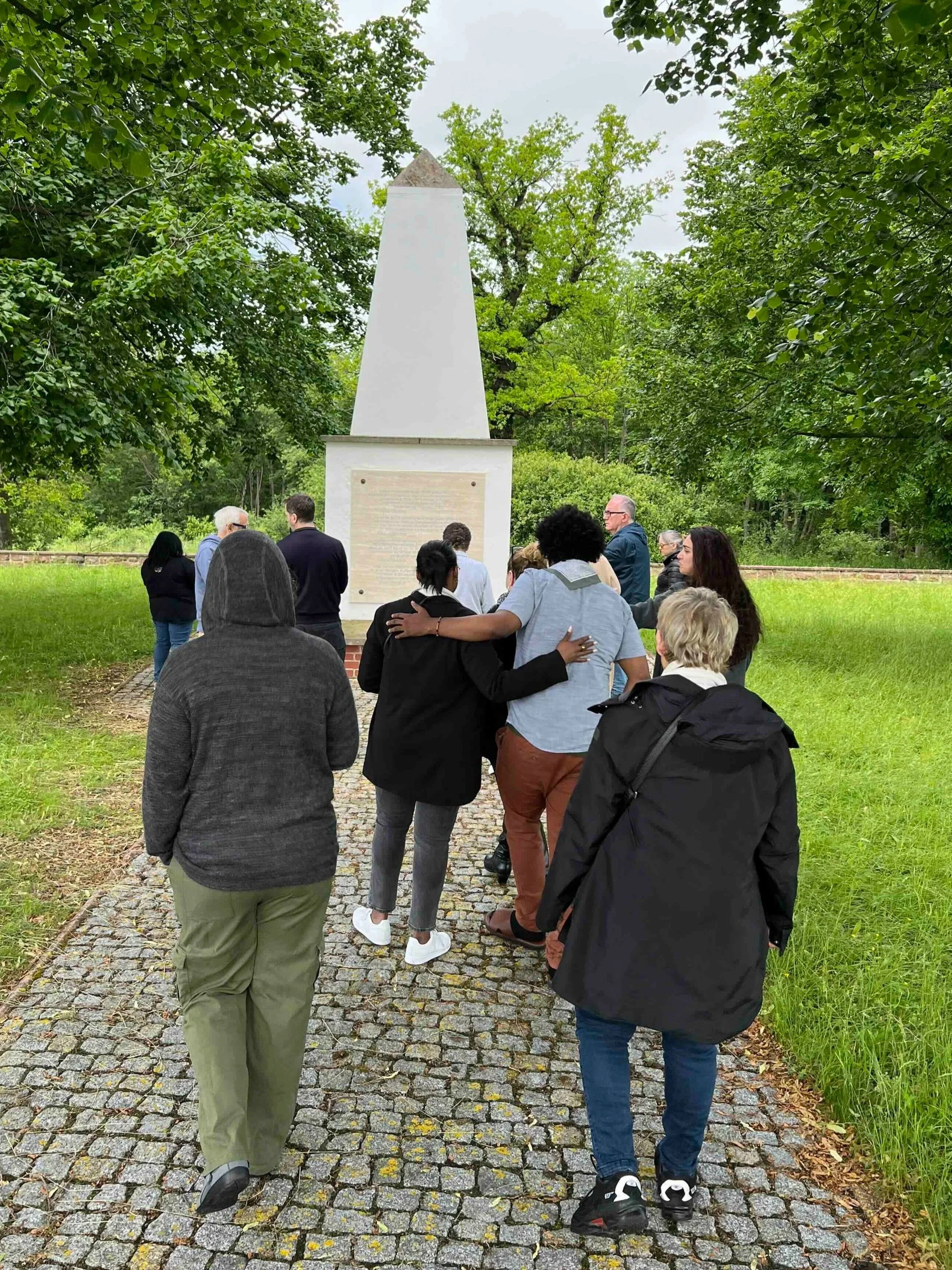Christoph Mauny
When Christoph Mauny and a group of teenagers showed the remarkable 360-degree video installation they had created to memorialize the former synagogue in the city of Gotha, Germany, things didn’t go exactly as planned.
The video was to be shown outside a shopping plaza, which stands where the synagogue was once located. A narrow outdoor walkway separates the two building that make up the mall. A large Star of David, a plaque, and a small model of the synagogue, all located along the walkway, are the only indications of what had once been there.
The long walls of the two mall buildings stand on each side of the walkway and served as the screens for the video presentation.
A handful of things occurred, all aimed at disrupting the presentation. During the week of the event, a swastika was carved into the Star of David. On the night of the presentation, nearby neighbors played very loud music in a clear effort to shut down the presentation. Fortunately, says Mauny, that didn’t work. “Our technical equipment was really extensive, and we had a lot of it.”
During the event, one of the handful of people who had come to disrupt the presentation gave a Nazi salute, aimed at a student of color. He was arrested immediately. But the student, who was frightened, called him a “Nazi pig.” She also was cited, for “insulting behavior.”
“That’s nothing but a perpetrator–victim reversal,” says Mauny.
More: Watch the short video about Christoph Mauny and read more about his work.
The presentation did take place, creating a powerful display for those assembled, and the video ran on a loop every night for a week.
However, media coverage focused on the incidents. “Due to these antisemitic crimes and disruptions, the discourse was suddenly in the hands of the perpetrators, and that was really sad. Nobody talked about the performance, the art, the content, the teenagers,” says Mauny.
Still Mauny, a 2024 Obermayer Award winner, believes firmly in public displays. The state where he grew up and where Gotha is located, Thuringia, is arguably the most far right-leaning state in Germany. He has experienced many acts of resistance and vandalism in pursuing his work, first for the Friedenstein Castle museum and now for the Weimar Painting and Drawing School.
The reaction of the right-wing shows the art installation was successful, he says.
“You see, we have just hit a nerve there. That was absolutely the impact. We couldn’t do it with an exhibition in the castle or in the museum. We could make an exhibition about Jewish history, but not with this impact.”
To get people interested in the synagogue project, Mauny asked students at local schools to come up with words that are in common usage in Germany that originate from Hebrew or Yiddish. Stickers were then created, each with one word, such as Schmonzes (nonsense) and vermasseln (luck), and the tagline “Nine centuries of Jewish life in Thuringia.” Students were urged to place the stickers over any hate speech they saw.
The synagogue projection on one wall of the shopping mall, with the Star of David in the foreground. See the 360-degree video.
“The stickers explaining the history of these words in a little short way, they were like this decentral urban action. Because they were everywhere, German Jewish words everywhere in the city over hate speech stickers, for example,” says Mauny.
Students know that the Nazis tried to erase any trace of Jews and Judaism from Germany. The stickers tell a different story, says Mauny. “[People] see that Jewish culture, Jewish life in Germany is alive. The Nazis did not succeed.”
For Mauny, public action that strikes a nerve is exactly the point. “There is this idea and this opinion and misunderstanding of remaining neutral,” he says. “Democracy is dying with this idea of being neutral. In my opinion the cultural foundation cannot and should not be apolitical. It should be a social actor and not a so-called neutral forum of the left and the right….This understanding of being neutral — where are the human rights? Where’s the constitution? Where is rule of law? We should stand up for these values.”
Although his background is in philosophy and not education, Mauny enjoys working with young people. “They are so creative and I really believe in this generation C,” he says. “They are so interested in this antidiscrimination stuff that we are talking about. I’m very very optimistic and hopeful with this generation.”
Remembering into the Future
Mauny currently is working on a project involving Camp Ohrdruf, a forced labor concentration camp that once imprisoned 20,000 people and is now a German military base. Ohrdruf was one of 139 subcamps of Buchenwald. There are two markers on the base noting the existence of the concentration camp. But the history is largely unknown in Germany. There are no markers outside the base, there is no official information about the memorial online, and to visit, people must call the base in advance.
The project, called “German Memory Gap: Concentration Camp Ohrdruf,” will create an ongoing multimedia memorial to the prisoners, including biographies, art, video, and more. The plan is to continue the work until the year 2100. The idea is that remembrance isn’t something you do once and it’s finished. The need for it continues. “That way we don’t [only] look into the past but also into the future,” Mauny says.
There is also a plan to create markers along the road, to let people understand what happened there. During one weeklong workshop, students made faces out of clay, which will be displayed along the roadside.
“Of course we all know that there will be destruction and vandalism, but [the remembrance efforts] will never stop. It will be a continuous procedure and continuous memorial,” he says.
Participants in Widen the Circle's 2024 Berlin Fellowship visit a mass grave site at Camp Ohrdruf.




